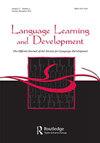Effects and Non-Effects of Late Language Exposure on Spatial Language Development: Evidence from Deaf Adults and Children
IF 1.4
2区 文学
0 LANGUAGE & LINGUISTICS
引用次数: 8
Abstract
ABSTRACT Late exposure to the first language, as in the case of deaf children with hearing parents, hinders the production of linguistic expressions, even in adulthood. Less is known about the development of language soon after language exposure and if late exposure hinders all domains of language in children and adults. We compared late signing adults and children (MAge = 8;5) 2 years after exposure to sign language, to their age-matched native signing peers in expressions of two types of locative relations that are acquired in certain cognitive-developmental order: view-independent (IN-ON-UNDER) and view-dependent (LEFT-RIGHT). Late signing children and adults differed from native signers in their use of linguistic devices for view-dependent relations but not for view-independent relations. These effects were also modulated by the morphological complexity. Hindering effects of late language exposure on the development of language in children and adults are not absolute but are modulated by cognitive and linguistic complexity.晚期语言暴露对空间语言发展的影响和非影响:来自聋人成人和儿童的证据
在父母听力正常的聋儿中,较晚接触第一语言会阻碍语言表达的产生,甚至在成年后也是如此。人们对语言接触后不久的语言发展以及语言接触后期是否会阻碍儿童和成人所有语言领域的发展知之甚少。我们比较了在接触手语后2年的晚期手语成人和儿童(MAge = 8;5)与同龄的母语手语同龄人在特定认知发展顺序下获得的两种类型的位置关系的表达:视图独立(in - on - under)和视图依赖(左-右)。晚期手语儿童和成人在视觉依赖关系的语言手段使用上与母语手语者不同,但在视觉独立关系的语言手段使用上没有差异。这些效应也受到形态复杂性的调节。晚期语言暴露对儿童和成人语言发展的阻碍作用不是绝对的,而是受认知和语言复杂性的调节。
本文章由计算机程序翻译,如有差异,请以英文原文为准。
求助全文
约1分钟内获得全文
求助全文

 求助内容:
求助内容: 应助结果提醒方式:
应助结果提醒方式:


